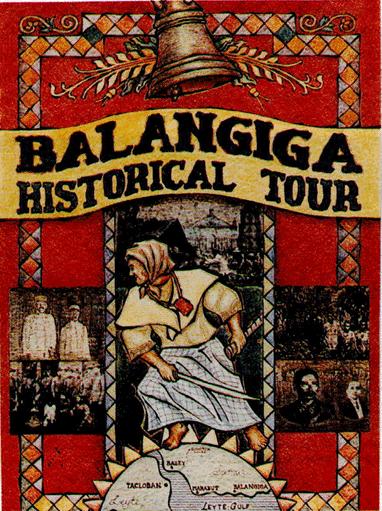Poster Art and Concept

The banig (straw mat) is a distinct product of the Leyte-Samar region. It is used here to symbolize the interwoven historical and cultural backdrop of the Balangiga Massacre. This most common dye colors for the banig -- maroon and green -- also happen to bee the U.P. colors. They allude to the University's role in popularizing the significance of the Balangiga event.
The bell at the center of the poster depicts the contested Balangiga bells and their symbolic value to the Philippine Centennial celebration. (The failed quest for the return of these relics from the U.S. in time for the June 12, 1998 commemoration remains a subject of continuing national and international debate and publicity.) The laurel leaves, a common banig motif, signify victory for the Filipino aspirations in Balangiga.
The cross that outlines the graphics at the center of the poster suggests the Christian undertones of the Balangiga Massacre, which the native plotters viewed as a fight between good and evil.
In the middle portion of the cross is the artist's illustration of the memorialized Balangigan fighter. Dressed as a church-going native woman, and with bolo drawn, he braces for the attack to be signaled by the ringing of the church bell.
On the top portion of the cross is a picture of the diorama depicting the start of the attack on the American soldiers stationed in Balangiga.
On the upper half of the left portion of the cross is a picture of Maj. Gen. Adna R. Chaffee (left), Army Commander of the Division of the Philippines, and Brig. Gen. Jacob H. Smith (right). Smith implemented the American reprisal operations after the Balangiga Massacre and gave the order to reduce Samar into a "howling wilderness." At the bottom is a picture of some American survivors in Balangiga and the church bell they took with them.
On the upper half of the right portion of the cross is a picture of conscripted native carriers or guides, eleven of the likes of whom were executed after a forced march across the jungles of southern Samar by U.S. Marines under the command of Maj. Littleton W. T. Waller. At the bottom are bust pictures of Gen. Vicente Lukban (left), the Aguinaldo-appointed politico-military governor of Samar at the time of the Balangiga Massacre, and Capt. Eugenio Daza (right), Lukban's subordinate officer who coordinated the attack on Company C, Ninth U.S. Infantry Regiment, stationed in Balangiga. Both pictures were superimposed on a picture of Filipino revolutionaries.
The arch with triangular protrusions at the bottom of the poster depicts the rising sun of freedom, which the Filipino victory in Balangiga symbolized.
The vicinity map inside the arch shows the places associated with the Balangiga Massacre. The significance of each place is explained in the brochure.
The design of the poster was by Prof. Rolando O. Borrinaga. This was rendered into art by Raul D. Agner, president of the Atitipalo Group of Artists in Palo, Leyte.